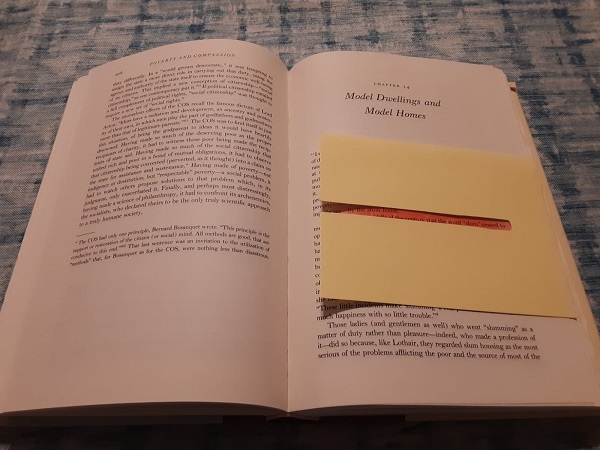Archives and the Road to Accessibility
Sometimes Archives Accommodate Invisible Disabilities—but Not Always
It’s 9 a.m., and as I walk into the building housing the archive I need to work in, I wonder if it will be a productive day for my research or if the words on the pages will all blur together. The archivist on staff might not allow me to bring my reading strips into the room. They’re only simple pieces of colored paper that might look like trash, but they’re assistive technology—so necessary for my executive function when I’m reading and sorting pages of notes. Some archivists prefer me to use white strips, but that color won’t allow my brain to break up the text sufficiently enough for me to read it. I am a history graduate student with an invisible disability, and every time I do archival research, I have to hope I will be accommodated.

Reading strips are an assistive technology that can help researchers read and take notes. Angela Gallagher
The Americans with Disabilities Act, passed in 1990, requires accommodation of a variety of disabilities, both visible and invisible. While the discipline of history, like much of the rest of society, has gradually become more accommodating of some visible physical disabilities in the last decades, the accommodation of intellectual and invisible disabilities has lagged. Of course, in educational settings individuals with invisible disabilities receive a variety of accommodations, including more time on exams and note takers, potentially allowing for greater participation in graduate school. But history has a problem: many archives remain as inaccessible as they were in the 1990s to individuals with invisible disabilities. By being more conscious of how archives can limit access to people with invisible disabilities, we may both fulfill the inclusive goals of the ADA and broaden participation in our discipline.
Today, ADA compliance within archives primarily extends to individuals with visible physical disabilities, although this too can be uneven. Standard accommodations include wheelchair ramps and accessible entrances, bathrooms, and seating. Some archives, such as those run by the National Archives and Records Administration, offer some materials in braille or other formats accessible to people with visual disabilities, but many do not. Researchers who are deaf or hard of hearing may encounter communication obstacles in smaller archives that lack interpretive staff. Yet archive websites in the United States, when they discuss the accommodations offered, most often focus on access for people with physical or visible disabilities. It’s much rarer to be able to learn about accommodations for invisible and intellectual disabilities.
The importance of education regarding accommodation for invisible disabilities may be seen in updated guidelines for archival access proposed this year by the Society of American Archivists. While some of the suggested guidelines are common ADA standards, the suggested accommodations for invisible disabilities are innovative in their acknowledgment of the population’s varied needs. These include allowing the use of “text-to-speech” software for visitors, transcriptionists if needed, items such as reading strips, and at least one height-adjustable reading table. The guidelines also state that individuals with sensory needs might require alternative venues for research. Further recommendations include digitization, which would allow individuals of all abilities to access materials in a way that would best suit them.
History has a problem: many archives remain as inaccessible as they were in the 1990s to individuals with invisible disabilities.
The guidelines’ suggested accommodations of both visible and invisible disabilities prompt questions about the issues of cost, time, space, and labor on archives’ part. Text-to-speech software, an accommodation/service frequently used by individuals with dyslexia, executive functioning disorders, and even physical disabilities, is challenging to use in an archival setting where all researchers share space, such as a reading room. Space is always at a premium in archives, and providing a “quiet room” for those who need sensory accommodations, or space for researchers who use text-to-speech software, could be expensive. But these accommodations would help equalize access to archival material and should be strongly considered as priorities.
More importantly, however, digitization could be a more cost-effective accomodation over the long term. While some archives have begun to digitize their collections, which would allow individuals of all abilities to access more of their materials, others have not. That could be because digitizing materials comes with its own associated costs, which many people don’t understand: curation, equipment, and technical expertise can all be expensive. But digitization also can increase access for all historians, not only individuals with disabilities. Digitized archives would allow visually disabled researchers to “listen” to the material via text-to-speech software, or use magnifying/distraction-reduction software. Digitization seems like the best first step in making archives accessible to everyone.
The benefits of these accommodations might not be readily apparent to nondisabled historians. But we cannot ignore that it is vital to make archival work accessible, since it’s often foundational for graduate-level seminar projects, which must naturally precede professional historical work. As the field of history becomes increasingly diverse, we must consider how accessible information and research materials may be, regardless of where they are accessed. Otherwise, we risk reinforcing the idea that the discipline of history is only for the nondisabled or privileged. Greater accessibility and accommodation for invisible disabilities in archival settings will increase the use of archival materials and enable individuals who might not have thought about becoming historians a friendly environment to explore.
By incorporating the suggested accommodations from the Society of American Archivists, the historical and archival fields may both increase their potential outreach population and become more ADA compliant. My research depends on it.
Angela Gallagher is a graduate student at Duquesne University. Her academic interests include disability and its place in the historical narrative as well as “health” as a social construct within Empire. When she isn’t reading, she enjoys exploring new places with her partner and writing historical fiction.
Tags: Perspectives Daily Diversity, Equity, & Inclusion Research Archives

This work is licensed under a Creative Commons Attribution-NonCommercial-NoDerivatives 4.0 International License. Attribution must provide author name, article title, Perspectives on History, date of publication, and a link to this page. This license applies only to the article, not to text or images used here by permission.
The American Historical Association welcomes comments in the discussion area below, at AHA Communities, and in letters to the editor. Please read our commenting and letters policy before submitting.
Comment
Please read our commenting and letters policy before submitting.







